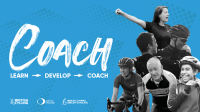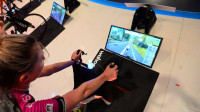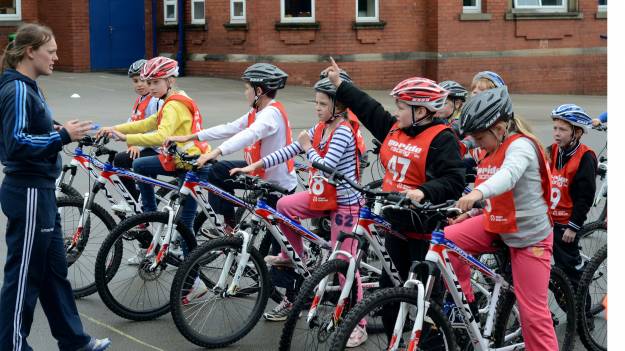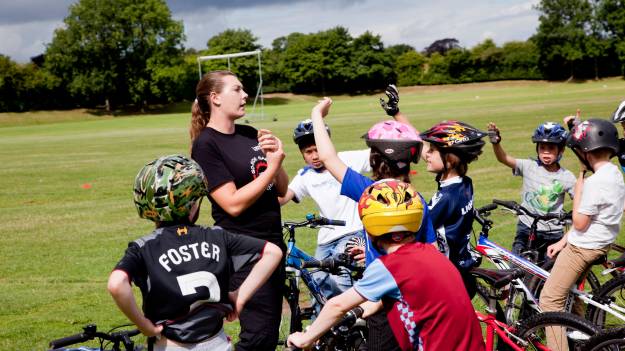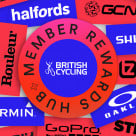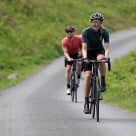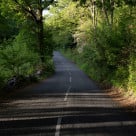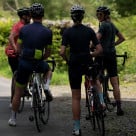Coaching Young Riders
July 2009
Coaching young riders can be an extremely rewarding and fun experience. It gives you the opportunity to ensure that their experiences of cycling and sport in general are positive and enjoyable. As a Level 1, 2 and 3 coaches it is important to be aware of how young riders respond to exercise. It is important to consider their basic physical, psychological and skill development during training and coaching activities as their bodies are not yet fully developed. In this months CPD article we are looking at the growth and physical development of young riders throughout childhood and adolescence and how issues associated with this should be applied during your coaching sessions.
Skeletal Development
 In children, the skeleton has to allow for growth, therefore, young riders who are still developing have bones that are softer and less rigid than those of adults. There are key points, known as epiphyseal or growth plates, in the major bones that are softer and these are where new bone is deposited. The majority of growth takes place at these plates. As the bone lengthens, the new bone or cartilage slowly hardens and becomes ossified (the development process of the skeleton). The full ossification of the bones is not complete until about 20 years of age. Therefore, bones, and, in particular, growth plates, may become damaged if subjected to excessive force. In addition, the tendons and ligaments are also developing as children grow. The sites where tendons attach to bone are often soft and weak during development. Therefore, the tendon or bone is susceptible to damage if excessive load or force is placed on them. This could be sudden damage, such as a fracture or torn tendon, or repetitive damage, such as a hairline fracture caused by continual overload.
In children, the skeleton has to allow for growth, therefore, young riders who are still developing have bones that are softer and less rigid than those of adults. There are key points, known as epiphyseal or growth plates, in the major bones that are softer and these are where new bone is deposited. The majority of growth takes place at these plates. As the bone lengthens, the new bone or cartilage slowly hardens and becomes ossified (the development process of the skeleton). The full ossification of the bones is not complete until about 20 years of age. Therefore, bones, and, in particular, growth plates, may become damaged if subjected to excessive force. In addition, the tendons and ligaments are also developing as children grow. The sites where tendons attach to bone are often soft and weak during development. Therefore, the tendon or bone is susceptible to damage if excessive load or force is placed on them. This could be sudden damage, such as a fracture or torn tendon, or repetitive damage, such as a hairline fracture caused by continual overload.
To minimise skeletal or tendon damage, you should ensure equipment is suitable for the developmental stage of your riders and avoid practice involving high impact (e.g. bounding) until late adolescence. You should also encourage riders to develop their strength using exercises that involve supporting their own body weight (cycling is ideal for this).
Response to Exercise
It is generally accepted that children are more suited to aerobic than anaerobic activity, as their bodies' favour the production of energy using aerobic, rather than anaerobic pathways. Both the aerobic and anaerobic capacities of children increase with age and growth. From birth, the aerobic and anaerobic capacities of boys and girls increase at a similar rate until the age of 12-14, where they increase at a greater rate in boys than in girls.
Regular participation in physical activity can improve the performance of children in both aerobic and anaerobic activities, particularly after the age of 12-14. However, these improvements are mostly due to improved coordination/neuromuscular skill and technique, rather than improvements in aerobic and anaerobic capacity. The size of these improvements is less than those expected in adults.
Children have smaller hearts and lungs than adults and, as a result, when they start exercising, their heart rates and breathing rates increase greatly to compensate. Children's maximum heart rates and breathing rates often exceed 220 beats pre minute (bpm) and 60 breaths per minute, compared to adults who generally have maximum heart rates of less than 200 bpm and breathing rates of 30-40 breaths per minute. When planning sessions for children, you should focus on developing technique and ensure that the volume is appropriate for their stage of development. As the riders develop and grow, the duration of activities and volume of exercise should gradually increase.
Safety Considerations
There are a number of factors you should consider when planning and delivering sessions, to ensure the safety of young riders:
- Temperature control - Young riders are less able to cope with great temperature extremes than adults. This is because their bodies are smaller and therefore, the surface area of their skin in relation to their total body volume is much greater. This makes them more efficient at heat exchange. In hot environments, children gain heat very quickly, but if their core temperature rises too much it can lead to overheating (which could lead to dehydration, heat exhaustion or heat stroke). Conversely, in cold environments children can lose heat very quickly, which can lead to hypothermia. This is not only due to their large surface area, but also because they tend to have a low amount of body fat, which may exacerbate heat loss in the cold.
- Injury - Young riders are not as good as adults are at recognising their limitations and the implications of their actions, which may cause injury. You can minimise the risk of injury by educating your riders on how to prepare for your sessions (such as talking to them during the warm-up), the potential dangers of specific actions, movements or equipment, and how to prevent injury. Tell riders to stop if they feel uncomfortable or in pain, and always conduct a warm-up and cool-down.
- llness - Ensure young riders are aware of the hazards associated with physical activity when ill, and encourage them to rest until they have recovered. In addition, you should know of any special conditions that may be exacerbated by exercise or present a possible health problem (e.g. asthma, diabetes), and check with parents what action to take if their child suffers with a specific condition during the session.
- Other - Make sure all the equipment and the cycling environment are safe by checking them prior to, during and after your sessions. Guide new riders through any specific safety routines or actions prior to the session and encourage all riders to set a good example. Stress the necessity of appropriate safety equipment for the activity (e.g. well-maintained bike, helmet and appropriate clothing). Ensure the weather conditions are conducive to safe and effective cycling, and advise riders of how the conditions may affect their safety (e.g. slippery surfaces on a wet day may affect cornering speed and braking distances). Also remember that cycling, like most sports, was developed for adults, so you will need to adapt and modify it to suit your riders' stage of development.
Ensuring you understand how riders grow and develop will allow you as a coach to effectively plan and deliver coaching sessions within the various discipline specific environments. More information on working with young riders can be found within the British Cycling Level 2 Coaching Handbook: Coaching Principles and Practice.

